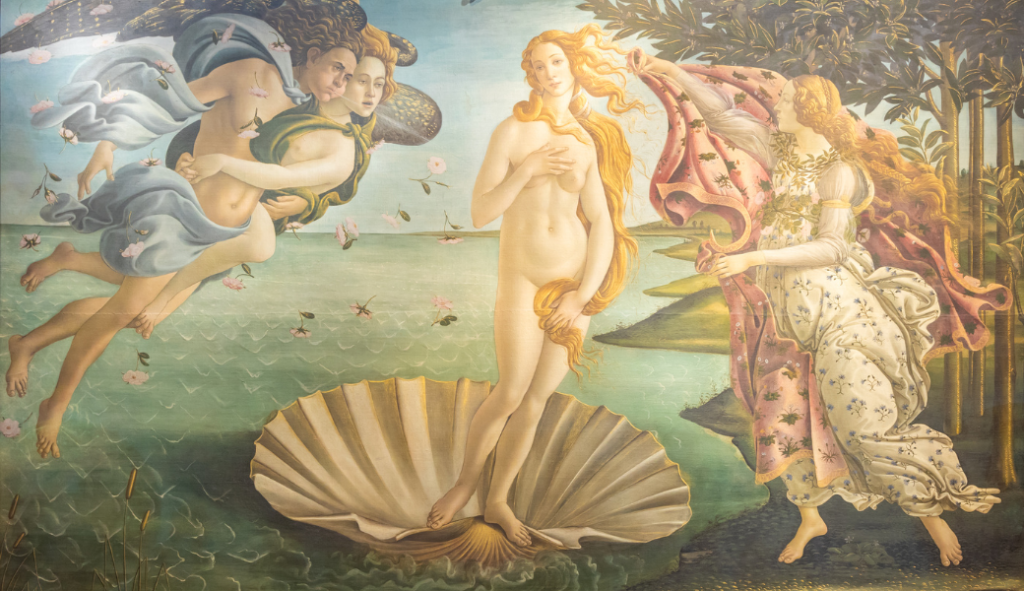Few paintings encapsulate the essence of beauty, mythology, and artistic mastery as profoundly as The Birth of Venus, by Sandro Botticelli. Created in the late 15th century, this masterpiece stands as a quintessential representation of the Italian Renaissance and remains a defining symbol of Florentine art and culture. Housed in the Uffizi Gallery in Florence, The Birth of Venus continues to captivate audiences with its ethereal beauty and rich symbolism.
A Mythological Vision
The painting portrays the mythological birth of Venus, the Roman goddess of love and beauty, emerging from the sea upon a shell, carried to the shore by the wind gods, Zephyrus and Aura. On the right side of the composition, a graceful nymph, often identified as one of the Horae (the goddesses of the seasons), awaits Venus with a flowing robe to clothe her in modesty. This scene draws inspiration from classical mythology and poets such as Ovid, whose works describe Venus’s birth from the sea foam.
Botticelli’s Artistic Genius
Botticelli’s distinctive style is evident in The Birth of Venus. The elongated forms, delicate contours, and flowing movements create a sense of elegance and dreamlike beauty. Unlike some of his contemporaries who pursued strict realism, Botticelli favored a more lyrical and decorative approach. The soft pastel colors, intricate details, and harmonious composition contribute to the painting’s enchanting quality.
One of the most remarkable aspects of the work is its sense of weightlessness—Venus appears to float rather than stand, her golden hair billowing in the wind, adding to the divine and surreal atmosphere. Botticelli’s technique, characterized by fine lines and subtle shading, enhances the painting’s ethereal nature, making it an unparalleled vision of grace and femininity.
The Inspiration: Simonetta Vespucci
A compelling aspect of The Birth of Venus is the belief that the central figure was inspired by Simonetta Vespucci, renowned for her exceptional beauty in 15th-century Florence. Simonetta, born in the Ligurian town of Portovenere—aptly named the “Port of Venus”—married Marco Vespucci, a cousin of the explorer Amerigo Vespucci. Her allure captivated many, including artists and poets, earning her the epithet “La Bella Simonetta”.
Art historians suggest that Botticelli used Simonetta as a model for several of his works, including The Birth of Venus. Her features—flowing golden hair, delicate face, and graceful demeanor—align with the depiction of Venus in the painting. However, it’s noteworthy that Simonetta passed away in 1476, approximately a decade before Botticelli completed this masterpiece. This temporal gap suggests that Botticelli either painted her from memory or idealized her features to represent the goddess of love and beauty.
Rumors of a Love Affair with Giuliano de’ Medici
Adding to the intrigue surrounding Simonetta Vespucci are rumors of a romantic liaison between her and Giuliano de’ Medici, the younger brother of Lorenzo the Magnificent. Giuliano was known for his charm and was a prominent figure in Florentine society. During a jousting tournament in 1475, he famously carried a banner depicting Simonetta as “La Sans Pareille” (The Unparalleled One), painted by Botticelli, and declared her the “Queen of Beauty”.
While these gestures indicate Giuliano’s admiration, concrete evidence of an affair remains elusive. Some accounts suggest a romantic connection, while others view their relationship as courtly and symbolic, reflecting the chivalric traditions of the time. The true nature of their relationship continues to be a subject of speculation among historians.
Symbolism and Meaning
Beyond personal inspirations, The Birth of Venus is laden with symbolic meaning. The painting reflects the Neoplatonic ideals prevalent in Florence during the Renaissance, which posited that physical beauty was a reflection of divine beauty and truth. Venus, therefore, represents not only physical love but also spiritual and intellectual enlightenment.
The sea, symbolizing life’s origins, underscores themes of rebirth and transformation, while the shell, often associated with fertility and femininity, emphasizes Venus’s role as the embodiment of beauty and creation. The presence of the wind gods suggests movement, change, and the life-giving power of nature.
A Lasting Legacy
Over the centuries, The Birth of Venus has inspired countless artists, designers, and scholars. Its influence permeates various art forms, from fashion to cinema, where Venus’s pose and composition continue to be referenced and reimagined. The painting remains a testament to the enduring power of Renaissance art and the timeless appeal of beauty.
For those visiting Florence, viewing The Birth of Venus in person at the Uffizi Gallery offers an unforgettable experience. The painting’s delicate details and luminous quality invite viewers to immerse themselves in its world of myth, poetry, and artistic brilliance.

